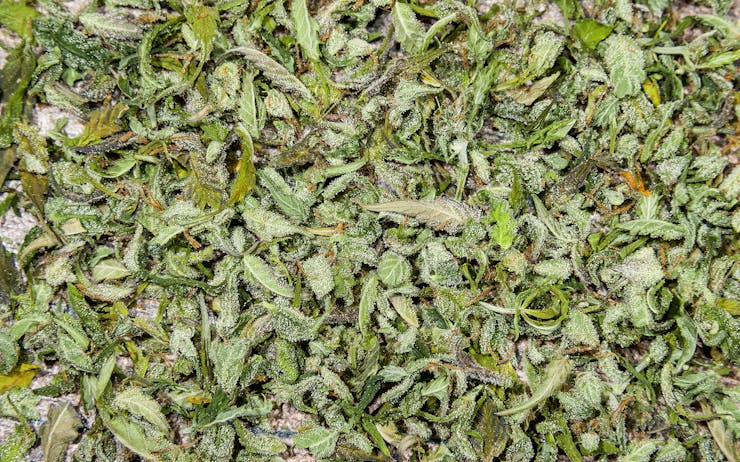This article is sponsored by Integra by Desiccare. Integra™ by Desiccare manufactures a complete line of humidity control products for the cannabis industry. Whether you’re drying, curing, storing, or preserving edibles, they have the solution to keep the freshness, potency, taste, and overall quality of your product.
Harvesting healthy, strong-smelling cannabis is a wondrous experience. As every branch is taken off the plant, you notice the subtleties between colas. Density, structure, and color amongst other traits stand out as your relationship with the plants deepens in this final stretch. All that’s left to do is to trim, dry, and cure the buds – but there’s a lot that can go wrong in these last steps if you aren’t prepared.
Farmers dry and then cure the plant slowly to bring out the best qualities of their buds. Unfortunately, this means the fresh plant will spend a lengthy amount of time in a climate where mold can quickly take over and ruin your harvest. Let’s take a closer look at the types of mold that can affect your plants during this time.
What Is Bud Rot?

The common name for the mold that will develop in humid climates is known as “bud rot” or Botrytis cinerea. This mold can develop while the plant is living, drying, or curing. Because it develops at the stem and spreads outward, it can be difficult to detect without closely inspecting your buds.
When first developing, the mold will appear wispy and grayish-white in color. Removing infected areas early on can potentially save the rest of the cola, however, by the time the mold reaches the surface the entire cola might be ruined.
The infection on the surface compared to the inside of the bud can be compared to an iceberg above and below the surface. Once the mold reaches the surface, the damage inside the bud is exponentially worse. A bud infected with bud rot will become gooey and lose its structure; the firm qualities of a dense flower will be replaced by malleable plant matter that feels wet and slimy. Once the mold begins to grow, it can also release additional spores and infect other buds that are drying.
Preventing Mold While Drying and Curing Cannabis

It is impossible to prevent mold spores from traveling into your curing space. Mold spores have been found everywhere, from the desert to Antarctica to the International Space Station. But just because the spores are everywhere doesn’t mean that specific types of mold will actually grow everywhere. Like other living things, molds have requirements that dictate where they will grow. This is where we as growers can protect our cannabis while curing.
The cannabis should be fully trimmed before it enters the curing phase. Buds should appear how you want them to appear when they will be consumed, which includes clipping them down to their desired size and removing excess stems. The cannabis should not crumble when squeezed nor feel moist to the touch, and the stems should snap when bent.
At this point, the cannabis can be put into jars or airtight totes to begin the curing phase. Once inside these containers, moisture from the stems and buds will seep into the air and the rest of the buds. This moisture being released removes impurities from the buds, but also it is what puts buds at risk for mold during curing. From here there are a number of ways to protect your product from molding as the curing process begins.
Products and Methods to Prevent Cannabis Mold

The first method involves using two-way humidity regulator packets. Integra Boost packets are a commonly used brand in the industry, and will maintain either 62% relative humidity (RH) or 55% RH, depending on the type you order. These packets can be found online or in local grow shops and will cover most the groundwork required for curing cannabis.
Using the 62% RH packet will keep cannabis from either drying out or molding as it slowly cures. Then, as the curing process moves forward, you can move to the 55% RH packets to further dry your product if desired. The Integra packets come with replacement indicators which will show you when you need to replace them, as opposed to using a hygrometer to measure the RH. The packets can be used for weeks or months depending on the climate and the moisture of the buds placed in the curing containers.
The other method involves opening the curing containers and letting humid air out. This is known as “burping.” It typically is done two to four times per day as the cannabis cures initially and is necessary less frequently as the RH percent drops. This method requires daily attention to detail and opens up a large amount of room for error, since it’s done by hand. Also, if you live somewhere with high humidity levels, burping the containers might actually be letting in air that has too high of a RH, which can cause your buds to remoisten.
Curing the cannabis you’ve grown is the last step before you get to enjoy your hard work. However pretty, smelly, and sticky your buds look when they are finished in the drying room, putting them through a quality curing process will always improve the product. One of the best things about growing your own cannabis is controlling this curing process; many large companies, by comparison, are hard-pressed on deadlines and do not have time to let their cannabis cure to its fullest potential. So take the time, invest in products that will ensure the best possible end product, and enjoy!






